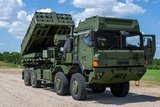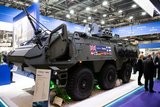USMC tests M320 grenade launcher
The US Marine Corps is testing the M320 grenade launcher module at Camp Lejeune, North Carolina, the corps announced on 9 June.
One of the first USMC unit to be issued with the M320 - Bravo Company, 2nd Combat Engineer Battalion - is carrying out the firing and handling testing. The M320 has already been in use with the US Army.
The M320 offers a number of capabilities superior to that of its predecessor, the M203. The M320 can be fired as a separate weapon system without being attached to a host weapon, and the sights on the M320 are more user friendly and flexible, increasing the chances of the projectile landing on target with the first shot.
Loading of the M320 barrel from the side allows for longer projectiles with increased velocity. This is different from the M203, which limits the size of projectiles the operator can use, due to the placement of the barrel on the bottom of the weapon system.
The M320 is designed to engage groups of enemy personnel, vehicles, bunkers, provide suppression and obscuration on objectives and mark targets to aid in direct fire. The weapon allows maximum coverage in sectors of fire that direct-fire weapons cannot engage.
Related Equipment in Defence Insight
More from Land Warfare
-
![Lithuanian 1st Division to achieve initial operating capability in 2026]()
Lithuanian 1st Division to achieve initial operating capability in 2026
Lithuania is one of the countries stepping up its defences in the face of the war in Ukraine with a particular focus on its neighbour and Russian ally Belarus, which has been making incursions into Lithuania’s airspace with balloons and drones.
-
![Beyond Survivability: How Active Protection Systems Are Empowering Commanders (Podcast)]()
Beyond Survivability: How Active Protection Systems Are Empowering Commanders (Podcast)
As threats diversify and intensify, APS are proving essential not just for vehicle protection but also for enhancing operational freedom, effectiveness and mission success in contested environments.
-
Medium knocked out of British Army LMP, with CAVS as heavyweight champion
As the British Army seeks to modernise and consolidate its diverse vehicle fleet, yet another change in direction is underway.






















